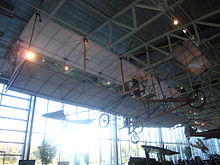Curtiss Model D Video - Picture

|
|
Curtiss Model D
Curtiss Model D

Picture - A "Headed" Curtiss Model D (Curtiss photo 1196) Pusher later "Headless" models incorporated elevators around the rudder in the tail (like most aircraft since).
Role:
Manufacturer: Curtiss Aeroplane and Motor Company
Introduced: 1911
Status: historic
Primary user: Exhibition Pilots, Aeronautical experimenters
United States Navy
United States Army Signal Corps
The 1911 Curtiss Model D (or frequently, "the Curtiss pusher") was an early United States aircraft of a pusher-prop design with the petrol engine and propeller behind the pilot's seat. The basic aircraft model was among the very first aircraft in the world to be built in any quantity - all of which were produced during this trial and error era of explosive aircraft development and equally important parallel technical development in internal combustion engine technologies.
It was also the aircraft model that first took off from and landed on a ship - different United States Navy ships on separate days as it happened. It was based on aviation pioneer Glenn Curtiss' aileron using Curtiss Golden Flyer design of 1909, itself derived from his prize winning June Bug of 1908. The design evolved from having the control elevators in front of the pilot in the so called head, to the familiar one of most aircraft since with the elevators located along the tail (called the "Headless" variant) along with the rudder. Like all Curtiss designs, the aircraft utilized ailerons to control rolling in flight instead of the Wright brother's patented wing warping technology.
Development
The Model D was a biplane fitted with a wheeled tricycle undercarriage. The construction was primarily of spruce, with ash used in parts of the engine bearers and undercarriage beams, with doped linen stretch over it. The outrigger beams are made of bamboo. Prevented by patents from using the Wright brothers' wing warping technique to provide lateral control, Curtiss used ailerons instead. In the end, this proved to be a superior solution. Almost all Model Ds were constructed with a pusher configuration, where the propeller is behind the pilot. Because of this configuration, they were often referred to as a "Curtiss pusher". Early examples were built in a canard configuration, with elevators mounted on struts at the front of the aircraft in addition to a horizontal stabilizer at the rear. Later, the elevators were incorporated into the tail unit, and the canard surface arrangement dispensed with, resulting in what became called the Curtiss "headless" pushers.
In addition to amateur aviators, Model Ds were purchased by the United States Army and Navy as airborne observation platforms. A number of them were exported to foreign militaries as well, including the Russian Navy. On 14 November 1910, Eugene Ely took off from the USS Birmingham in a Model D. This was the first time an aircraft had taken off from a ship. On 18 January 1911, Eugene Ely landed a Model D aboard the USS Pennsylvania. This was the first aircraft to land on a ship.
Upon his election to Congress in November 1915, Orrin Dubbs Bleakley became the first government official to fly from his home state to DC. The trip was made in a 75 hp (56 kW) Curtiss biplane from Philadelphia, piloted by Sergeant William C. Ocker, on leave from the United States Aviation Corps at the time. The trip took 3¼ hours, including an unscheduled stop in a wheatfield in Maryland.
Variants
Model D-4
with one 40 hp (30 kW) Curtis four-cylinder inline engine
Model D-4
with one 40 hp (30 kW) Curtis four-cylinder inline engine
Model D-8
Signal Corps Aeroplane Number 2, one 40 hp (30 kW) Curtis Vee engine, top speed of 60 mph (97 km/h) at sea level
Model D-8
Signal Corps Aeroplane Number 2, one 40 hp (30 kW) Curtis Vee engine, top speed of 60 mph (97 km/h) at sea level
Model D-8-75
with one 75 hp (56 kW) Curtis eight-cylinder Vee engine
Model D-8-75
with one 75 hp (56 kW) Curtis eight-cylinder Vee engine
Burgess Model D
single prototype built under licence by Burgess Company of Marblehead, Massachusetts
Burgess Model D single prototype built under licence by Burgess Company of Marblehead, Massachusetts
Existing aircraft and reproductions

Picture - Curtiss Model D at College Park Air Museum
A number of Curtiss Pusher original and reproduction aircraft exist, and reproductions of the design date as far back to the era when the original aircraft was in production, mostly built by private parties.
The Old Rhinebeck Aerodrome has had a flyable reproduction Model D pusher in their collection since 1976, and has been powered with a Hall-Scott V8 engine earlier in its weekend airshow appearances, and most recently has been powered with a Curtiss OX-5 V8 engine.
The College Park Aviation Museum built a replica of the Curtiss Model D once flown in 1911 at College Park Airport in Maryland.
There is a Model D with an O-300 (145hp) Cont. Engine at the Owls Head Maine Transportation Museum also.
Operators
United States
United States Army
Aeronautical Division, U.S. Signal Corps
S.C. No.2 (1911-1914)
United States Navy
Specifications (Model D Type IV)
General characteristics
Crew: one, pilot
Capacity: 1 passenger
Length: 29 ft 3 in (8.92 m)
Wingspan: 38 ft 3 in (11.66 m)
Height: 7 ft 10 in (2.39 m)
Empty weight: 700 lb (318 kg)
Loaded weight: 1,300 lb (590 kg)
Powerplant: 1x— Curtiss E-4 V8 engine, 60 hp (45 kW)
Performance
Maximum speed: 50 mph (43 kn, 80 km/h)
Endurance: 2.5 hours
Related development
AEA June Bug
Curtiss Golden Flyer
Curtiss Albany Flyer
Curtiss Model E
Curtiss Model D Pictures
More aircraft.
Source: WikiPedia